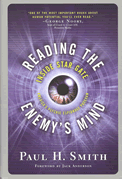|
Paul Smith was one of the U.S. military's remote viewers. Reading the Enemy's Mind is his account of that psychic espionage program as he experienced it. By the time he published this book in 2005, there had already been a large number of other military remote viewers who had published their own remembrances of what happened during those years of the program's existence in the latter part of the last century. So with Smith's book, it is natural to ask if anything new is added to the extant historical accounts. The answer is a resounding yes, and this book must be considered required reading for anyone trying to gain a full picture of what happened during those years. Each remote viewer who served in the military's original remote-viewing program has offered a slightly different perspective on those years. All of the basic ingredients of the story are the same. (1) A psychic espionage program existed in both the U.S. and Soviet governments. (2) The U.S. program was primarily located in the U.S. Army via the Defense Intelligence Agency (D.I.A.), although the C.I.A. had its own early interest in the potential of using psychics for spying. (3) Ingo Swann developed a set of procedures that were often used by many (although not all) in the U.S. program. (4) Much of the early research into psychic functioning was conducted a Stanford Research Institute. (5) There were a number of outstanding successes in the use of the novel espionage methodology. (6) Controversy surrounding the program when its existence became publicly known, causing the program to be dismantled. (7) There was always a shortage in funding for the basic science issues relating to the mechanism of psychic functioning. (8) The U.S. government pushed the operationalization of the methodology before understanding its underlying mechanism. Beyond these eight basic points, together with the cast of characters who filled this program over the years, there has long been debates about what happened and when. In Reading the Enemy's Mind, Paul Smith tries to tie as many loose ends together as possible, and by and large he succeeds. Nonetheless, there will always be some controversy about the U.S. military's original psychic espionage program, and Smith's effort will not resolve all of the disputes. Each person who participated in the program will continue to have his or her own recollection of what happened. This is important to recognize because each person had a somewhat unique experience in a program that truthfully was continually growing in new and experimental ways. In an established program of any sort, there is a commonly excepted pedagogy for instruction, and the bureaucracy relies on settled rules of conduct for day-to-day matters that express more repetition than novelty. But this program was different. Everything was new. The Army itself was not even fully comfortable with where to put it, which is why there are so many interesting stories of how much of the program (but not all) existed in rather run down (almost ramshackle) accommodations at Fort Meade. Thus, my own perspective is to accept Smith's new and exceptionally rich account of this psychic espionage program at face value, while acknowledging that some differences will remain between the various participants. Smith's book is an essential re-telling that finds some of its greatest value in its level of detail. Smith clearly tries to document his experience in the U.S. military's espionage program as thoroughly as possible. He relies not only on his own memory, but on a collection of interviews of a large number of those involved in the program. He also relies on dated notes that were written by some of the important figures in the program. Thus, while there will likely never be a final definitive version of this highly interesting chapter in the history of military intelligence, Smith's book is probably as close as one is going to get to such an account. Since there is little disagreement among the primary players regarding the main ingredients of this program, readers should be aware that any differences that do exists between the various participants focus more on details and interpretation. At this point, no one should challenge the basic eight points as listed above, and Smith's book places those points in a valuable historical context. One of the most interesting (and truly new) elements that is added by Smith's book is a forward by the newspaper columnist, Jack Anderson. It happens that Mr. Anderson was one of the highly visible critics of the U.S. military's venture into psychic methodologies for espionage purposes. It also turns out that he gained significant indirect exposure to the program over the years and has now become a critic of his own initial opposition. Few people eat crow as bluntly and courageously as Mr. Anderson has done in the foreword to Paul Smith's book. Readers should be sure to read this. Two remaining points need mentioning. First, Smith's account is abundant with autobiographical detail. His writing style is clear, and his prose is descriptively rich. Readers will feel like they are traveling with Paul through those exciting years as they turn each page. Finally, this book contains one of the best descriptions anywhere of how the U.S. government both realized the true data-gathering potential of this new methodology, and simultaneously over-exploited and fundamentally misused the available resources. That period of time was filled with military and political crises, and the government's remote viewers were asked to do far more than they possibly could have competently accomplised given the available resources and the lack of understanding of the underlying mechanism of psychic functioning. This led to confusion and the eventual collapse of the government's program. There are many lessons that can be learned from this history. While Paul Smith's book is worth reading for many reasons, avoiding the repetition of past mistakes is one of the best. |

